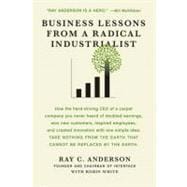
What is included with this book?
| Acknowledgments | p. ix |
| Foreword | p. xi |
| Prologue | p. xvii |
| Mission Zero | p. 1 |
| The Power of One Good Question | p. 7 |
| One Small Digression and Six Lessons | p. 20 |
| Mountain Climbing | p. 29 |
| Zero Waste: The First Face of Mount Sustainability | p. 44 |
| Smokestacks and Other Relics | p. 62 |
| Plugging into the Sun | p. 86 |
| Round and Round They Go | p. 110 |
| Getting Out of the Breakdown Lane | p. 128 |
| The Circle of Influence, or Love on the Factory Floor | p. 151 |
| The Final Ascent | p. 174 |
| On Leadership, Programs, and Policies | p. 191 |
| Science and Skeptics | p. 215 |
| Awakening the Mind and Spirit | p. 225 |
| The Next Ascent | p. 244 |
| Every Reason for Hope | p. 261 |
| Epilogue: Off the Grid in Lost Valley, North Carolina | p. 273 |
| LCA Comparison of Two Carpet Tile Backing Types | p. 285 |
| Master Evergreen Lease and Services Agreement | p. 287 |
| The Interface Model | p. 290 |
| Index | p. 292 |
| Table of Contents provided by Ingram. All Rights Reserved. |
The New copy of this book will include any supplemental materials advertised. Please check the title of the book to determine if it should include any access cards, study guides, lab manuals, CDs, etc.
The Used, Rental and eBook copies of this book are not guaranteed to include any supplemental materials. Typically, only the book itself is included. This is true even if the title states it includes any access cards, study guides, lab manuals, CDs, etc.